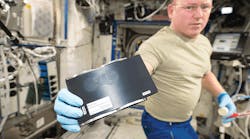Finding the right tools for a job is a difficult task for any operation. Finding a new ratcheting socket wrench while in space on board the International Space Station (ISS) is particularly perplexing.
Normally, such a request would have taken months of planning to complete and could have only been fulfilled as part of a multi-million-dollar, extremely risky supply run from Earth.
When ISS Commander Barry Wilmore said he needed this new wrench, engineers at Made In Space went to work on designs for a ratchet that could be 3-D printed in space. What's more, they designed a tool that included all internal moving parts without any support material that was capable of being built in a single print—an ideal design for the challenges of space manufacturing.
Within a week, the design was finished and tested and sample prints were brought to NASA for qualification. NASA e-mailed the files to the Zero-G Printer onboard the ISS and—after just four hours of printing—Commander Willmore had his ratchet.
This is the first of what should become a steady stream of 3-D printing stories coming out of the ISS in 2015.
After SpaceX delivered Made In Space's Zero-G Printer in September 2014, 3-D printing has been quickly finding a place with the crew. It began with a custom-printed nameplate for the printer itself—a kind of token “functional” print to kick off the project—and 20 other prints that were preloaded before delivery.
The ratchet is something different, though. This is the first truly functional test of the printer—a design created by a centralized team on-the-fly to meet a specific need and printed exactly where it is needed.
It fulfills both the promise of the space-printing project and also the localized printing dreams back down here on Earth. One day, this model could be used to print on-demand parts and supplies for military and remote populations cut off from normal supply routes, as well as home printers downloading new designs.
Travis Hessman is chief editor of MH&L's sister publication, New Equipment Digest.



